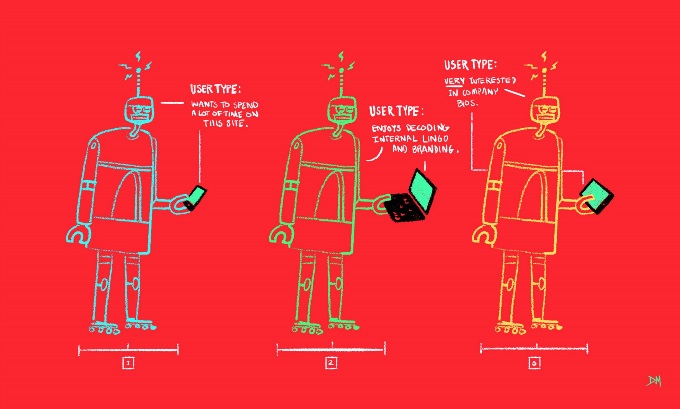Made-Up Personas Don't Work
5 min read
Most user research guides will tell you to create user personas, brief descriptions of user groups personified by one representing person. Great idea! Personas can be a strong piece of foundational user research. But we’ve read the advice readily and widely available about making personas, and we’d be hard pressed to name an article that hasn’t left us asking one thing: “Where are the bleeping users?”
Where Are the Users?
Most web development firms recommend one of two approaches: 1) Think really hard about the people using your product and then make up personas about them, or 2) Talk to your internal stakeholders and then make up personas based on those interviews.
The lack of actual users in either process is, to put it mildly, glaring. How can you make personas that are supposed to reflect your users without talking to a single user? And yet that’s what most web development shops do, and advise without shame (if they even engage the point at all). We’ve even seen so-called user experience firms suggest making personas without nary a user present. What!
Here’s the thing. Personas made by the most tuned-in internal stakeholders or the smartest interactive designer will never help your digital product succeed.
If you guess, you’ll guess wrong.
Making personas without talking to users is like guessing how much fuel you’ll need to get to the moon without talking to anyone familiar with the actual rocket. It’s not based on anything real. It will always be a guess and even the best guess will be wrong.
Worse, made-up personas that presuppose user behavior may lead you so far astray from what people really need that your digital product doesn’t solve any of the problems it was created to solve. That makes your entire project a waste of time and money.
Personas Made by Users Lead to Project Success
If you want to ensure your website, application, or software suite does what users need it to do, have your users make the personas.
Only users know about users.
You are not the user. Your internal stakeholders are not the user. So you and your stakeholders can’t create effective user personas. You can only guess how users will interact with your digital product.
That meeting with stakeholders where you talk about the users? Scrap it. Stakeholders can tell you about internal goals, the problems the organization wants to solve, upcoming initiatives and obstacles. They can’t help you make personas.
Those personas your business analyst, marketing team, or web designer came up with? Throw them away. They’re not real, they’re made-up, and they won’t work.
We will say it until we’re blue in the face. Go to the users. Go to the users. GO TO THE USERS.
Users can reveal project-changing issues.
Bonus points: When you talk with users about their real-world actions, you’ll learn things you never even dreamed about. You’ll learn things your stakeholders have no idea about. You’ll learn things that genuinely surprise you. These realizations are a huge part of why we do Discovery, or project research, in the first place. This approach solves the tough problems, makes the huge business improvements, and leads to overall success.
Engaging Users in Persona Creation
A caveat: Don’t do just whatever users tell you.
We’re not saying you should let users dictate personas directly. Instead, guide them through persona creation, giving them the real-world questions you need answered and probing for their real-life needs and pain points. We are saying raw material for personas must come from users. Put it through a professional user experience filter, and you’ll be all set.
Focus on what matters.
Engaging with users to make personas means you’ll be working with real user tasks, traits, and pain points. You’ll learn exactly what your users need your digital product to do and what makes them want to tear their hair out.
Ask users to answer:
- What do I want and why do I want it?
- What gets in the way?
- How do I currently complete my tasks?
You want to know about real-world tasks and use. Toss out random information that may or may not be helpful, like excessively ornate demographics and tangential behavior patterns. When users tell you what real world tasks they must complete using your product and what gets in their way of success, you’re getting real feedback.
Real user feedback means you can confidently proceed.
You can now extrapolate how your digital product can solve users’ problems. You don’t have to worry that your opinion is off-base – if you did your persona creation correctly, the very people using the site, application, or software suite told you how they need to use it.
That real user feedback also wins you ammo against any unwanted meddling from stakeholders, bosses, CEOs, etc. For example, when someone higher up says they want to put company bios on the home page, you can tell them that reading company bios doesn’t fit with any of your users’ tasks. The users themselves made no reference to the pressing need for dense marketing lingo or internal structure. Made-up personas can be explained and argued away until they don’t matter anymore (if they ever did in the first place). It’s extremely hard to argue with feedback from real users.
Real Personas Will Improve Your Digital Products
Switch to making real personas with real user input instead of settling for made-up ones from your team. It’s a crucial step in substantially improving the user experience and success of your digital products.
When real users inform your strategic planning, you swap guesswork and unsatisfying digital products for successful websites, applications, and software that will help solve your toughest business problems.





